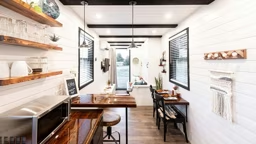
Photo by Scott Graham / Unsplash
Unless you hit the Powerball jackpot, chances are you’ll need a loan to build a cabin from scratch. Even if you’re paying with cash you’ve saved, read on for tips about spending that money wisely during the construction process.
Head to the bank
Your first step is to determine your budget. “You don’t want to begin looking at floor plans and lots without knowing how much money you’ll be able to borrow,” says Becky Luzinski, a commercial loan officer at Illinois National Bank.Neil Johnson with Northview Bank in Minnesota recommends meeting with a lender to look at your whole financial picture. “An experienced loan officer can help you find the least expensive way to get the money you need,” he says.
A loan officer will aid you in assessing what you can borrow, but you need to keep your ongoing everyday expenses in mind, as well. The bank will explain the different types of loans available. A construction-to- permanent loan allows you to pay for construction costs then roll into a permanent mortgage with just one set of closing costs. Some of these loans can also be used to finance the purchase of land. All costs of building the cabin are considered – including architectural and engineering fees and permit costs.
You can also choose a construction- only loan, but keep in mind you won’t be able to lock in your mortgage interest rate until after the construction project is completed. Loans to purchase raw land are also available, Johnson says.
See also Building on a Budget
To assess how much money you qualify for, the bank will look at your income and assets and closely scrutinize your credit history. Higher credit scores may be necessary for a loan on a second home. The bank will likely require you to use a licensed general contractor for the project. If you’re a DIYer keen to take on the building project yourself, remember that a bank could ask for proof that you have the skills and know-how for the job.
To qualify for a loan, Luzinkski says borrowers should expect to provide a fully signed and completed building contract, a breakdown of the general contractor’s costs and a complete set of building plans including materials specication. You will also need a deed or contract on your land.
You will need a down payment based on the appraised amount of the future cabin. “Land does act as collateral,” Johnson explains. So, if you own your land and it is valuable enough, you may not need an additional down payment.
How the loan works
A construction loan allows for “draws” over its lifetime to pay for services and materials. During the construction phase, your loan basically acts as a line of credit. The bank typically requires inspections before dispersing funds to ensure that the project is on track. During construction, you only pay interest on money that has been paid out by the bank. You won’t owe interest on the full amount that you plan to borrow right at the outset.When construction is finished, the appraiser will make a final inspection. “Once he or she states the home is 100% complete, and we have final lien waiver clearance from the title company, we’ll be able to move you to a mortgage loan that best ts your circumstances,” Luzin- ski says. The construction-to-permenant loan rolls directly into a mortgage with no additional closing costs. If you have chosen a construction-only loan, you will need to secure a mortgage at this point.
See also Financing Your Rennovation
Special situations
If you plan to build a log cabin, your financing picture might be a bit different. The Log and Timber Homes Council of the National Association of Home Builders (NAHB) recommends finding a lender who has experience with log homes to help make the process easier. Experience with log lending means the bank understands that a signi cant portion of the construction loan will need to be paid early in the process to the log package producer. The experienced lender will also understand how to evaluate comparable sales.If your lender has not worked with log projects and would like more info on appraising this kind of home, you can point him or her to an appraisal guide published by the Log and Timber Home Council. It’s available online at loghomes.org/how-to- appraise-log-homes.
Financing the building of a new cabin with home equity credit from your existing home can be a good solution. But, Johnson warns, “It depends on how much risk you want against your permanent residence.”
If you forego financing and decide to use your own cash, consider using a third- party inspection company, like the banks do, to evaluate progress before you write checks to your contractor or tradespeople. Work out a schedule for payments with your contractor before the project begins, so everyone has a clear understanding of when payments will be made.










